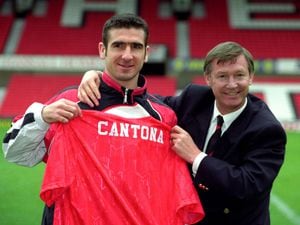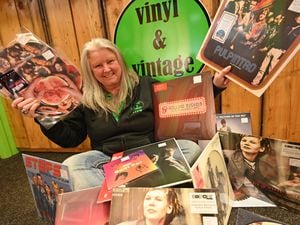Proud to have been at the ‘art of a Goldie era
Martin Jones was there at the beginning of it all for Goldie and the original pictures of his spray can, Hip Hop days remain on display
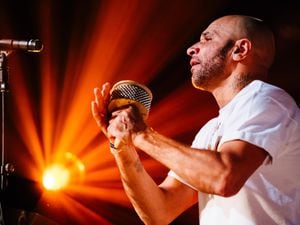
He’s the archetypal rags-to-riches boy who dun good. Growing up in deprived inner city areas, to Jamaican and Scottish heritage, meant the cards were stacked against Goldie. He’s gone on to receive an MBE and become world renowned as a musician, producer, DJ and artist.
Goldie moved to Thailand in 2015 – but not to kick back and relax, far from it. He has opened a gallery in Bangkok, showcasing contemporary, urban, and street art from around the world. The gallery is located in an up-and-coming neighbourhood of the Thai capital and has even prompted a Sky Arts programme.
There’s little doubt that the now-55-years-old Clifford Joseph Price would have got to where he’s going with or without help.
A force of nature, a fizzball of energy, he’s built his life around creative endeavour. The roots of his work lie very much in the Black Country, where he was born and where he suffered physical and sexual abuse in care homes before being a breakdancer, graffiti artist and hip-hop star.
But during his journey to success, he met an art teacher, Martin Jones, who managed his career during the formative years from 1984-90, when he was living in Heath Town.
At the time, Martin took hundreds of photos of the emerging Hip Hop scene, including Goldie’s early graffiti artworks and his breakdance crew the Wolverhampton B Boys.
The original slides and negatives of the Zulu Dawn UK Hip Hop Archive are now kept at Dudley Archives.
It is an important record of the beginnings of urban culture in the UK, which have been used in the past by companies such as Red Bull and ITV for programmes about the beginnings of ‘street’ culture in the 1980s.
Martin says: “Back in January 2020 ‘Somethin’ Else’, who make programmes for Sky Arts, approached me for consent to use pictures from the archive in a documentary about the history of Street Art called ‘Goldie: The Art That Made Me’.
“In the film, Goldie talks about his early days as a graffiti artist in Heath Town; they also filmed his old friend Gary Birdie Burns travelling around Heath Town in his new BMW, talking about the graffiti art murals they once created on walls in the city.”
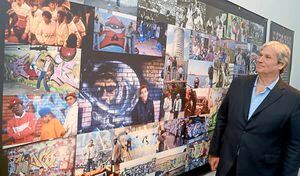
The programme is fascinating. Fronted by Goldie, it traces the spread of graffiti art and hip-hop culture from New York and Florida to London, Wolverhampton and Bristol, ending with a visit to today’s cutting-edge street artists in Lisbon.
Martin was part of that journey. He was a youth worker when he met Goldie, based in Smethwick. His passion for hip hop led him to form a group called the ACE Squad, who organised a festival with the B Boys.
Goldie was part of the B Boy’s second generation. Martin made friends with them, taking a trip to Wolverhampton to meet them.
They were all dancers, apart from Goldie and a character called Birdy, who were graffiti artists.
Martin says: “They showed me their work on the walls in Heath Town.
“From that, I realised that they had a very special talent. From my youth work background, I decided to try and get them legal, commercial opportunities to do their art. Right from the start, I knew that Goldie had something special because they all had some kind of message for the people living on Heath Town or for his generation. Some of them were just him advertising himself, of course, but others were social commentary. There was one called Catch Me If You Can. He had a whimsical angle on everything he did. The Can, in Catch Me If You Can, was a spray can. Goldie was one step ahead.”
Another art work was called World War III, which depicted a Russian and an American missile. Art provided Goldie with a release for his creativity and he frequently wrote poems to accompany his graffiti. “He was a kid without an outlet for his work. Clearly, he and others were influenced by the artists in new York who were working on the trains.”
Martin met Goldie around 1984 and within a year he was securing commissions for the fledgling Heath Town graffiti artist. Though Goldie was interested in music, it wasn’t until later that he made it a career. “I remember that he was always interested in the musical side of things and the conversation was just as much about the latest hip hop sounds form New York as it was what he was planning to do in his next mural. I was surprised that he focused on it later but delighted too. Art was clearly important to him.”
In fact, it wasn’t until Goldie moved to London and parted ways with Martin that he began to make his way in music. A peripatetic soul, he’d also spent time in New York and Miami, where he’d sold grills – gold teeth. Those trips had given him the opportunity to make money while immersing himself in hip hop culture.
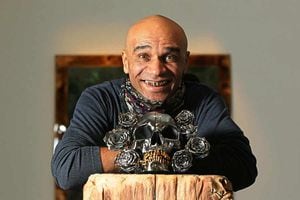
Martin says: “After 1990, we gradually lost contact then about five years later, when I was at Wolverhampton Art Gallery, somebody told me he’d brought out Timeless.” The record, Goldie’s debut, revolutionised jungle and remains a masterpiece of the times.
“It took me aback that he’d focused on music and made so much from it. 3D from Massive Attack was really helpful for him. I think he brought him into the circle that included Nelly Hooper. The fact that 3D made something of Massive Attack really inspired Goldie to go in his own direction.” And yet, in many ways, it was not so surprising that Goldie prospered. During the years from 1984 to 1990, Martin saw enough of him to realise he would flourish.
“I was just impressed by his overwhelming energy and relentless creativity. I never ever had an argument with him. We were on the same wavelength. We wanted to achieve the same things, to get his art onto a high profile.”
It was through lawful, fee-paying commissions that Goldie’s art developed. His first big commission came from Wolverhampton Council in 1985 and within a year Martin and Goldie were on a flight to New York, with Birdy. They were filming a programme about graffiti and met some of the most successful artists of the time. They provided Goldie with inspiration and by the time he returned he was ready for his own exhibition at Wolverhampton Art Gallery, called Art Writers.
“By night, he was The Wild Criminals. By day, his legitimate self was The Supreme Graffiti Team. he had Birdy – Gary Burns – and also Cliff Malcolm – Lew – and that was the crew. We did quite a lot of commercial work. We did one at the NEC for Telecom Soft, which was around at the time. Much later on, there was a bus in Walsall, which was for Pink Lady, the cocktail drink; he did the outside of a West Midlands Travel bus for them. That was the commercial side.”
Goldie’s name began to get around. He was invited to the World Street Art Championships, in East Yorkshire. Goldie entered in 1987 and 1988. Organisers got 20 artists from across the world to take part, including New York, Austria, Paris and from Norway. Martin recalls: “He took part in that and it was on Bridlington Sea Front.
“Everybody had a 20ft long by 8ft high blank set of hoardings. They had eight hours to create a graffiti art mural. He had a very, very big rival from London, Mode, who based in Covent Garden. They tried over the years to outdo one another.”
In every new mural, Goldie produced something new, never repeating himself. “He was not complacent. He was always striving to do something better. That’s also been the case in his life as a musician.
“He was very, very innovative. He was a very warm, man. I could take him to meet anyone, whether it be video producers or a BBC director. I’ll give you an example. The BBC had heard about his work. In 1988 they commissioned him to do a world record attempt – the longest mural in a day: 40ft long by 8ft high. He did it in eight hours. Floella Benjamin saw him off on the attempt and Simon Bates concluded it.
“The viewers watched over the course of a day. In terms of temperament, he was brilliant. He was happy to liaise with the technical staff, meet celebrities; he was always comfortable.”
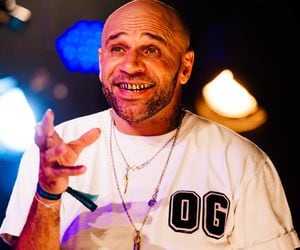
Martin took a job at Wolverhampton Art Gallery in the summer of 1989 and continued to represent Goldie. There final work together came when The Lighthouse was opened. Big hoardings were put around the site and Goldie was commissioned to complete a mural. “At that point, he’d already gone to London and was living with Gus Coral, the co-producer of a documentary called Bombing. Goldie spent about four years lodging.
“I stayed in touch with him. I did a promotion for Citreon down in London where they wanted to display some of the canvasses that were done in the 1980s and Goldie came along to that. In terms of a working relationship, he went to London and I stayed in Midlands. I was the promotions officer at the art gallery. I organised the big Thunderbirds exhibition with Jerry Anderson, back in 1992, for a year. It involved going to London to meet Jerry and source all the puppets, which were with private collectors over the country.
“I was constantly astounding at the high level of his achievements. First of all, there was the musical side, which in itself was astounding. But he was his own man, as well. He had his own company, Metalheadz, and he really led that collective of drum and bass musicians. He was not only able to publish his own music, he was working with others in the same field to promote them. That was an admirable achievement. He diversified into other things and got a part in the World Is Not Enough, Pierce Brosnan’s James Bond movie, playing a Russian criminal.
“He was in EastEnders too. I think he was in Celebrity Big Brother and he became friends with Prince Harry too, somehow, to put together a musical collective to perform at the Palace. That was for people from inner city areas with talent. He got them together into a group to perform at Buckingham Palace. He’s just always been a remarkable man.”
Martin is proud of the archive that he collected during the 1980s, which pays testament to a key moment in our region’s social and cultural history.
Though the Black Country is best known for heavy rock and heavy metal, it was also the start point for one of the most important urban artists that Britain has ever produced.
“I’m just very proud of him and glad that I spent those years representing him. From Glastonbury to London nightclubs, from his gallery in Bangkok to TV, he’s done it all. He has a huge vision. He sees an expanding market and wants to lead.”
Martin still lives in Sedgley. These days, he runs a local history archive, rather than mentoring young hip hop talents.
He is ever proud, however, to have played a small part in developing the career of one of this region’s greats.



